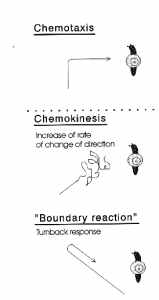Research on Miracidia

Different host-finding behaviour |
The host-finding
Host-finding of miracidia is a complex process which is guided by environmental (gravity and light) as well as snail host signals.
Miracidia respond to chemical snail host signals with different behavioral patterns, which lead to accumulation around and finally to contact with the snail.
Three different orientation behaviors of miracidia are known, an increase of the rate of change of direction (RCD) when entering and a turn back response
when leaving the active space around the snail (HABERL & HAAS, 1992), as well as a directed chemotactic response. Up to now
the last mechanism mentioned has been found only in one species, Schistosoma japonicum (HAAS et al., 1991).
After contact with the snail host miracidia show a special behavior called repeated investigation.
|
The attracktive molecules
| Tab. 1: Stimulating molecules for S. mansoni miracidia described so far. |
| Stimulating molecule |
Reaction |
Published by |
| N-Acetylneuraminic acid |
Attachment |
MCINNIS, 1965 |
| Aminoacids |
Turnback |
MCINNES et al., 1972 |
| Serotonine |
Accumulation |
ETGES et al., 1975 |
| Magnesiumions |
Accumulation |
STIBBS et al., 1976 |
| Peptides |
RCD |
BROWN, 1976 |
| Ammoniumions |
RCD |
MASON & FRIPP, 1977 |
| Glutathione |
Accumulation |
DISCO & WEBER, 1979 |
| D-Glucose |
Accumulation |
PLORIN & GILBERTSON, 1985 |
| Beta-Ecdyson |
Accumulation |
SHIFF & DOSSAJI, 1991 |
| Macromolecules from SCW |
RCD & Turnback |
HABERL & HAAS, 1992 |
The chemical snail host cues that release these behavioral patterns have been thoroughly investigated since more than 30 years,
however the results were very different and sometimes contradictory (Tab. 1).
Our own research led us to the surprising conclusion that none of the small molecular signals so far investigated plays a role in miracidial
host-finding. We found that for miracidia of different species (S. mansoni, S. haematobium,
Trichobilharzia ocellata, Fasciola hepatica and Echinostoma caproni)
macromolecular glycoconjugates from snail conditioned water (SCW), presumably originating from snail mucus, are the releasing cues for all investigated
host finding behaviors (HABERL & HAAS, 1992). This homogeneity is in sharp contrast to the diversity of signals which are involved in
cercarial host-finding.
However, miracidia of some species are able to recognize their host snail from other snail species and this high specificity seems to be encoded in the complex
macromolecular signals (HABERL et al., 1995, 2000; KALBE et al., 1996, 1997, 2000). We already cleaned the SCW from unattractive
compounds by anion exchange chromatography and size exclusion chromatography. The results of current analysis of the attractive glycoconjugates by PAGE,
lectines, HPAEC/PAD, HPLC and FAB-MS of different snail species are presented in Tab. 2.
| Tab. 2: Characteristics of attractive fractions after size exclusion chromatography: |
| Species |
Host Snail |
Specificity |
Size |
Main Sugar |
Bound Lectines |
Structure |
| S. mansoni (Egypt) |
Biomphalaria alexandrina |
high |
700 kDa |
Galactose |
AAA,PNA,GNA,WGA |
not available |
| S. mansoni (Brasil) |
Biomphalaria glabrata |
poor |
1000 kDa |
Galactose |
AAA,PNA,GNA |
not available |
| T. ocellata |
Lymnea stagnalis |
high |
300 kDa |
Galactose |
AAA,PNA |
not available |
| F. hepatica |
Lymnea truncatula |
high |
300 kDa |
Galactose |
AAA |
not available |
| E. caproni |
Biomphalaria alexandrina |
poor |
1000 kDa |
Galactose |
AAA,PNA,GNA |
not available |
Another aspect of this research is the development of miracidial traps (HAAS et al., 1998), which could be
used for schistosomiasis control.
- On the job:
Wilfried Haas,
Bernhard Haberl,
Jan Hertel,
Alexander Holweg
 Homepage
Homepage
